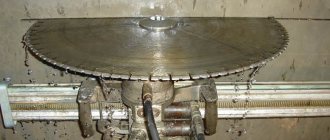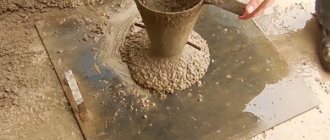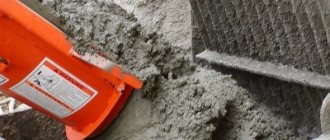The production of concrete and mortar mixtures is carried out in factories or SBU (mixing and concrete unit). This is where all the components of the concrete mixture are mixed. Namely:
- cement;
- crushed stone;
- sand;
- water;
- additives.
The prepared mixture is supplied to the vehicle and must be transported to the site where it will be used.
The transportation process is important because this time can be lengthy and detrimental to the prepared mixture. That's what we'll talk about today.
Basic rules of transportation
When transporting concrete and mortar mixtures, it is necessary to take into account such an important indicator as the setting time of cement. Since cement is the main binder in the composition of concrete, it forms the main adhesion process of all components mixed in the mixture.
Thickening of the cement paste will be considered setting. But they also define a process such as hardening of the concrete mixture. It is at this moment that the concrete begins to gain real strength. But let’s return to the setting time; it is assumed that C3A (tricalcium aluminate) and C3S (tricalcium silicate) are the first to react among the clinker minerals. The main minerals in Portland cement will be:
- C3S – tricalcium silicate or alite – is the main mineral of clinker, its content ranges from 40 to 60%. Reacts actively with water, especially at the initial stage;
- C2S - dicalcium silicate or belite - is less active than alite, heat generation is approximately two times lower and hardening is slow, lasting for several years;
- C3A – tricalcium aluminate or I also came across the name celite, but I’m not sure if it’s correct. This is the most active mineral in clinker; it quickly interacts with water and releases a lot of heat. It is also called “quickie” for its setting speed. Because of this, it is necessary to add gypsum to the cement to retard setting, otherwise the concrete will not be brought to the object;
- C4AF – tetracalcium aluminoferrite – this mineral does not actively generate heat, something between alite and belite. The strength characteristics are also in the middle position between alite and belite.
Knowing the composition of the clinker, one can also assume the characteristics of the development of setting of certain cements, which will be important for predicting the transport route.
And the main chemical reaction will be the hydration of cement, which is when the loss of concrete mobility begins.
For Portland cement, this period begins 45 minutes after mixing the cement with water, and ends after 12 hours.
This is where the challenge arises for transporting the mixture - you need to meet these 45 minutes before setting begins. And if you can’t do this, if the distance is long or there’s a traffic jam, what should you do? And if the atmospheric temperature is still high, then this factor accelerates the setting time. And if the temperature is low, then this delays the setting time. For all these reasons, transportation will be a very important process, compliance with strict rules of which will create the necessary conditions for the implementation of the construction task of concreting.
When transporting ready-made or dry mixtures, the following conditions must be met:
- loss of trains during transportation is excluded;
- Precipitation should not get into vehicles;
- during transportation, the homogeneity of the mass must be maintained; this does not mean that the mixer must spin continuously, but the driver must have a schedule for turning it on and off;
- It is unacceptable to violate the time regime of transportation in order to avoid loss of mobility and brand strength of the transported mixture.
Types of transportation:
- concrete truck;
- concrete mixer truck;
- body transport;
- pneumatic transport, belt conveyors, concrete pavers.
The most unfortunate form of concrete delivery is in dump trucks.
In the body, when moving on bad roads, part of the mixture splashes out on potholes, and with such vibration, the composition also delaminates, because cement laitance flows out through the cracks. The mixture becomes dehydrated and loses its quality as it hardens. Of course, you can increase the sides of the dump truck and seal all the cracks, but the problems will remain.
Only the use of concrete trucks called mixers solves almost all problems that arise along the way. Such vehicles are equipped with a teardrop-shaped body that rotates during transportation. Inside the mixer there are blades that help mix the existing mixture. These blades operate on the principle of an Archimedes screw, when when mixing, all components of the mixture move to the center of the mixer, and when unloading in the opposite direction, to the discharge hole. Such a unit has a concrete mixer and a dosing and washing tank, this allows you to prepare the batch directly on site, when the distance from the plant to the unloading site is significant. At the concrete plant, dry mixtures are poured and delivered in this form to the site, where water is added and mixed.
It is necessary to separate concrete trucks and concrete mixer trucks. Concrete trucks only transport ready-made mixtures, but mixers have an additional function - dosing tanks of water and additives. If transportation is carried out over long distances and dry components of the mixture are poured into the mixer, then the driver has a schedule for how long before approaching the object it is necessary to turn on the water supply and start preparing the batch. Usually this must be done 30-40 minutes before arriving at the site. Also, modern concrete mixer trucks have a double skin that contains thermal insulation filler for transportation in sub-zero temperatures.
It is not always possible to load the concrete mixture that arrives at the site directly into the formwork, so the following methods are used:
- taps in the dispensing tub, when it is necessary to move horizontally and vertically;
- pneumatic transport from a separately arrived 30-meter concrete pump;
- along vibrating chutes, when the mixture is unloaded into a vibrating feeder and vibrating chutes are connected to them at an angle of 10-15 degrees. Such a mixture should be fluid, not hard;
- belt conveyors that can deliver at a distance of up to 30 m. Such conveyors are now included with concrete mixers of some Kamaz series;
- large concrete mixing plants that supply concrete mixtures to concrete plants for pouring into metal molds for the production of panels.
Delivery methods
Concrete from the mixer to the construction site is transported by different types of transport:
- Road pneumatic transport (concrete trucks, concrete mixers);
- Transportation in buckets on dump trucks from the acceptance site to the formwork at the facility site;
- Belt conveyors, truck cranes, concrete pavers at a construction site.
Transportation of concrete can be carried out from the plant (mobile or stationary), either with subsequent reloading, or directly to the pouring site.
In practice, it is rare, but still there are cases of transporting concrete in the back of a dump truck. This is not the best way to transport the mixture due to various factors:
- Excessive vibration promotes the release of concrete milk;
- Open air helps the mass dry out. Even covering the body with a tarpaulin does not provide normal conditions for the peace of concrete.
The result is a loss of solution properties.
GOST 7423 – 2010. Concrete mixtures. Technical conditions.
This standard contains a chapter on Transportation and it describes the necessary requirements for transportation. For example, there is no prohibition on transportation by dump trucks in body transport, but it is necessary to agree on such a delivery method with the recipient, but this is only for rigid mixtures.
The transportation period should not deteriorate the properties of the concrete mixture, for which the supplier is responsible if he uses his own transport.
During transportation, atmospheric precipitation should not enter the mixture, delamination should not occur and laitance should not leak out.
The consumer and manufacturer must first agree on many factors, for example:
- delivery date and time;
- the frequency with which each subsequent mixer will be delivered;
- the recipient must warn the manufacturer what additional transportation will occur for all shipments directly within the construction site;
- what are the possible restrictions on the weight, dimensions and type of vehicle at the site.
It is unacceptable to add any components of the concrete or mortar mixture during transportation - cement, water, additives. Such procedures are only possible upon instructions from the supplier.
By agreement with the supplier, it is possible to carry out on-site procedures that restore the workability of the concrete mixture (plasticizing additives), but this must be specified in the technological map and documented in a document.
Supplying concrete mixture with cranes and lifts
Self-propelled tower and jib cranes with a set of buckets are used for batch supply and distribution of concrete mixture in concreting blocks. The mixture delivered by road is unloaded at the site into buckets and supplied directly to the structure by cranes. In this case, the concrete mixture moves both vertically and horizontally, which ensures its distribution during laying.
There are rotating and non-rotating tubs.
A rotary tub is a welded container consisting of a body, frame, shutter, and lever. Sometimes a vibrator is installed on the body of the tub. The frame is made in the form of a sled, the design of which allows the tub to be loaded in a horizontal position. When lifted by a crane, the tub is slung by the loops and it, smoothly rolling, takes a vertical position. In this position, the tub is moved and unloaded. When lowering the tub under loading, it smoothly assumes a horizontal position with the loading hole upward.
A fixed tub is also a welded container, but unlike a rotating one, it is loaded in a vertical position. Rotating buckets are primarily used; non-rotating buckets are used in cases where the concrete mixture needs to be supplied in small portions (into columns, walls of small thickness, etc.). Buckets are usually made with a capacity of 0.5...2 m3.
To move the concrete mixture only vertically, various lifts are used. Thus, when concreting the interfloor floors of frame buildings, post-type lifts are used, which lift the concrete mixture in buckets or containers. For horizontal transportation of the mixture, he uses wheelbarrows, rickshaws, scooters or motorized carts.
GOST 27309 – 2016 Concrete mixer trucks
This GOST spells out everything about concrete trucks, but here we will consider only a few, in our opinion, important points.
It applies only to mixers that transport concrete mixtures with a cone draft of more than 3 cm and aggregate size up to 70 mm. Cone slump is an indicator of the plasticity and workability of a concrete mixture. It is defined as follows:
Depending on the indicator A, a plasticity grade is assigned from P1 to P5. GOST for concrete mixer trucks allows the transportation of mixtures with a cone draft of 3 cm or more, which characterizes such concrete in terms of workability as very hard grade P1.
The grain size of the aggregate (crushed stone) should not exceed 70 mm, which is also a limiting factor, since a larger grain size can create blockages when unloading through the feed neck.
The mixer must have a system of mixture supply trays with the ability to change the height and horizontal feeding.
Transport must have an emergency unloading system in case of force majeure.
The device must have a water meter to determine supply volumes with an error of +2%, as well as the ability to install water tanks of various volumes.
The mixer itself must be provided with a thermal insulation shell between two bodies in order to transport products at temperatures ranging from +40 ℃ to -40 ℃.
Briefly about the main thing
- When ordering concrete, the question always arises of how to calculate the volume and not make a mistake. After all, if there is not enough, then it is very bad, there is a break in the continuity of the concrete mass and you cannot supplement it with anything. And if there is excess, where to put it? You should always play it safe and take it with a reserve, it’s more reliable.
- Concrete mixer trucks are produced in various sizes with a capacity from 3 to 12 m3 of concrete.
- The mixture can be prepared for use without deterioration in properties even during long-term transportation of 2 or even 3 hours. To do this, you must strictly adhere to the mixer's mixing mode.
- Constant stirring of the mixture in a mixer is unacceptable, as this will lead to separation and loss of the specified qualities of concrete.
- Concreting of large structures must be continuous and deliveries of the mixture by concrete trucks must arrive on schedule and the interval between them should not exceed half an hour.
- The cost of delivery of ready-made concrete is 15 rubles/km. cube These are the prices at one of the factories in St. Petersburg.
Transportation of concrete mixture by belt conveyors and concrete pavers
In industrial and civil construction, belt conveyors are used as intra-building transport for supplying concrete mixture, mainly when concreting structures with small dimensions in plan (point structures).
For the needs of builders, the industry produces mobile belt conveyors with a length of 6... 15 m and a width of a smooth or ribbed belt of 400... 500 mm. Such conveyors can deliver concrete mixture to a height of 1.5...4 m.
The main working part of the conveyor is a flexible rubberized belt that goes around the drive and tension drums and rests on supporting upper grooved roller bearings and lower flat roller bearings. The concrete mixture is loaded onto the belt through feeders, which allow the mixture to be continuously and evenly supplied to the required thickness.
The conveyor drums are equipped with devices that clean the belt from cement mortar and return it to the supplied concrete mixture.
To avoid stratification of the concrete mixture, its mobility when fed by conveyors should not exceed 6 cm. The angles of inclination of the conveyor when lifting the mixture with mobility up to 4 cm - up to 18°, 4... 6 cm - up to 15°, and when lowering the mixture - up to 12 and 10, respectively °. The belt speed should not exceed 1 m/s. When unloading from the conveyor, in order to avoid delamination, guide shields or a funnel with a height of at least 0.6 m are used. The installation of one-sided shields or canopies, as well as the free fall of the mixture from the conveyor, is not allowed.
Mobile belt conveyors, having high productivity (up to 35 m3/h), do not distribute the concrete mixture over the area of the concrete structure. Therefore, the conveyor has to be rearranged during the feeding process, which requires additional labor and causes delays in concreting.
More effective are concrete pavers, which are used to construct monolithic foundations for buildings and technological equipment, as well as other dispersed objects. A concrete paver is a self-propelled machine, on a rotating platform of which there is equipment for receiving concrete mixture and delivering it to the place of placement. The transporting element of the concrete paver is a telescopic belt conveyor, consisting of a main conveyor and a moving one. The concrete paver takes the concrete mixture from the body of the concrete truck into the bunker, from where it enters the main conveyor and then directly into the structure. Concrete mixture can be supplied to any point in the plan from 3 to 20 m with a boom rotation of up to 360° from one working position. The concrete paver can deliver the mixture to a height of 8 m, and also lower it below the parking lot with a conveyor slope of up to 10°.











